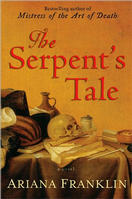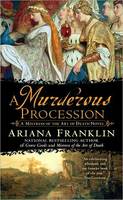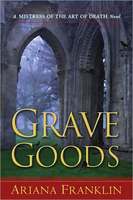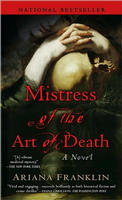
The Serpent's Tale
Mistress of the Art of Death #2
Putnam
Mystery, Mystery: Historical
January 31, 2008
ISBN-13: 0399154647
Available in: Hardcover
The Serpent's Tale
by Ariana Franklin
Ariana Franklin combines the best of modern forensic thrillers with the drama of historical fiction in the enthralling second novel in the Mistress of the Art of Death series, featuring medieval heroine Adelia Aguilar.
Rosamund Clifford, the mistress of King Henry II, has died an agonizing death by poison—and the king's estranged queen, Eleanor of Aquitaine, is the prime suspect. Henry suspects that Rosamund's murder is probably the first move in Eleanor's long-simmering plot to overthrow him. If Eleanor is guilty, the result could be civil war. The king must once again summon Adelia Aguilar, mistress of the art of death, to uncover the truth.
Adelia is not happy to be called out of retirement. She has been living contentedly in the countryside, caring for her infant daughter, Allie. But Henry's summons cannot be ignored, and Adelia must again join forces with the king's trusted fixer, Rowley Picot, the Bishop of St. Albans, who is also her baby's father.
Adelia and Rowley travel to the murdered courtesan's home, in a tower within a walled labyrinth—a strange and sinister place from the outside, but far more so on the inside, where a bizarre and gruesome discovery awaits them. But Adelia's investigation is cut short by the appearance of Rosamund's rival: Queen Eleanor. Adelia, Rowley, and the other members of her small party are taken captive by Eleanor's henchmen and held in the nunnery of Godstow, where Eleanor is holed up for the winter with her band of mercenaries, awaiting the right moment to launch their rebellion.
Isolated and trapped inside the nunnery by the snow and cold, Adelia and Rowley watch as dead bodies begin piling up. Adelia knows that there may be more than one killer at work, and she must unveil their true identities before England is once again plunged into civil war. . .
Other Books by Ariana Franklin
Ariana Franklin's Bio
Ariana Franklin was born in London just before World War II. During the war, she and her parents lived with her father's uncle, a minister in Winston Churchill's wartime cabinet. In London, Ariana had a privileged life, with a nanny, a maid and a chauffeur. But eventually her mother got tired of the constant air raids, so they went to live with Ariana's maternal grandparents in the seaside town of Torquay in Devonshire, leaving her father behind — permanently, as it turned out.
After her parent's divorce, Ariana and her mother had very little money and lived in a tiny apartment over a shop. It was very different from their days London, but in retrospect, Ariana was glad to have seen both sides of life.
To earn money, she left school at fifteen. Ariana had a great love of journalism—perhaps the only thing inherited from her father, a correspondent for the Times—so she looked for work in that field. By the age of seventeen she was back in London, working on a local paper in its East End, where she was spotted by a national newspaper. At twenty, she became the youngest reporter then in Fleet Street. Sadly, on her 21st birthday, Ariana was covering a murder on the South coast and missed her party entirely. "But, it's my birthday," she protested to her news editor when he told her to cover the murder. "Many happy returns," he said, "and now get down to Southampton."
Ariana found that she loved a reporter's life: accompanying the Queen on a visit to Paris, invading Wales, dressed for combat, her face blacked, on an exercise with Royal Marine Commandos under fire from live ammunition.
Marriage to a fellow journalist, Barry Norman, and Fleet Street didn't mix — he was always flying into the country as she flew out of it. So, not wanting another divorce in the family, Ariana gave up her newspaper career and instead settled down in the country, giving birth to two daughters within fourteen months of each other. With a child on either hip, she continued to write. Anything. Magazine articles, biographies, ghost stories. Most of all, history, especially women's history. How did we get here? Why didn't we get here sooner?
She became a specialist on the early Middle Ages, its justice, its climate, dress, food, habits, and crime. In fact, her first book, which dealt with the coming of the Common Law and the jury system under that great English kings, Henry II, received plaudits from university professors of history and won a BBC award for its accuracy and depiction of the twelfth century. Accuracy is important, Ariana believes. If a reader's paying you the compliment of buying your book, you've got to get it right.
So there she was, happily writing historical novels to good reviews and charting women's fight for equality through the ages. She had just dealt with the French Revolution and was wondering what the hell to do next when literary agent, Helen Heller, came into her life with an irresistible offer, "Why not write an historical thriller?"
Now, if Ariana's a sucker for anything, it's for Raymond Chandler's dictum: "When in doubt, have a man come in with a gun." But this time, the man with a gun needed to be a woman. So it was back to the twelfth century for Ariana—no guns, but lots of crossbows, and poison and daggers, and, believe it or not, a school of medicine in Salerno where women could train as doctors and where autopsy was permitted.
Thus Adelia, the 12th century female pathologist, was born to take up her role as "Mistress of the Art of Death" fighting medieval crime and speaking for victims who otherwise would have been forgotten. Sounds exciting? It is. It's a thriller. It's also, because Ariana Franklin's writing it, accurate, fascinating. And don't forget fun...







